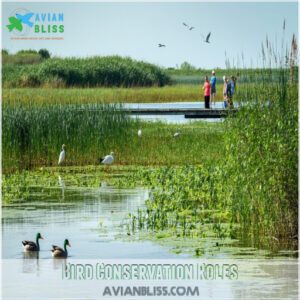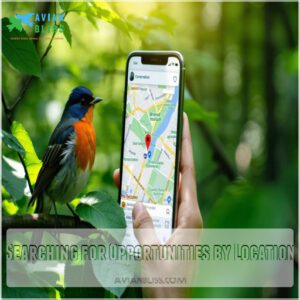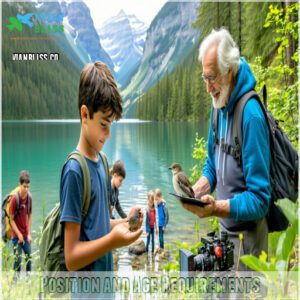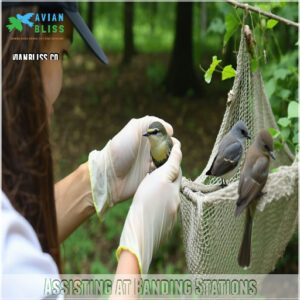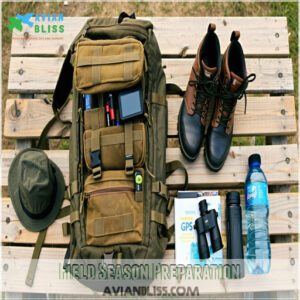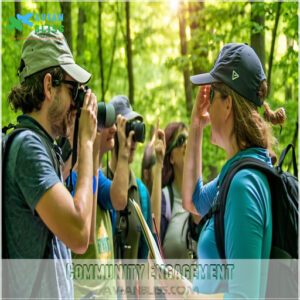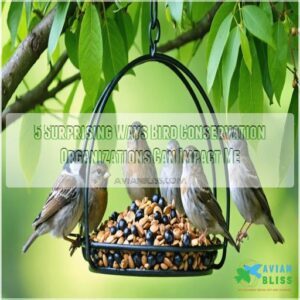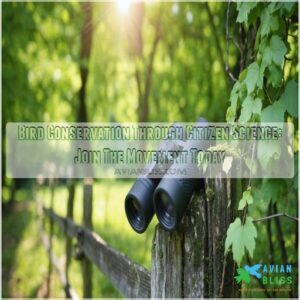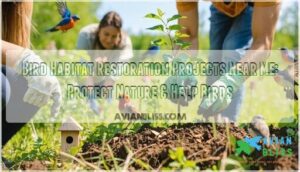This site is supported by our readers. We may earn a commission, at no cost to you, if you purchase through links.
 Ready to spread your wings in bird conservation? Bird conservation volunteer work offers you exciting opportunities to protect our feathered friends.
Ready to spread your wings in bird conservation? Bird conservation volunteer work offers you exciting opportunities to protect our feathered friends.
You’ll lead wildlife tours, restore habitats, conduct species surveys, and track migration patterns. From repairing trails to monitoring threatened species, these roles let you make a real difference.
You’ll develop skills in ecosystem assessment, data collection, and environmental education while contributing to critical research. Whether you’re staffing nature centers, participating in bird counts, or helping at banding stations, your passion becomes powerful action.
Each volunteer effort helps preserve biodiversity and supports essential conservation strategies that protect vulnerable bird populations across different ecosystems.
Table Of Contents
- Key Takeaways
- Bird Conservation Roles
- Volunteer Opportunities
- Bird Conservation Projects
- Community Engagement
- Education and Training
- Frequently Asked Questions (FAQs)
- What are the benefits of volunteering for Conservation?
- What does a nature reserve volunteer do?
- How do I volunteer for a Wildlife Center?
- How do I become a Bird Rescue Volunteer?
- How can I help save birds?
- What can volunteers do to help the environment?
- How can I make bird conservation a career?
- What skills do I need to volunteer?
- Are there opportunities for remote volunteering?
- How do conservation efforts impact bird populations?
- Conclusion
Key Takeaways
- You’ll contribute to vital research and data collection through activities like species surveys, migration tracking, and participation in programs such as the Christmas Bird Count and Climate Watch initiatives.
- You can choose from diverse roles matching your interests and abilities – from hands-on fieldwork like habitat restoration and trail maintenance to office support with data entry and visitor center operations.
- You don’t need specialized qualifications to start – patience, reliability, and attention to detail are the core skills you’ll use while receiving training and mentorship to develop expertise in bird conservation.
- You’ll develop valuable career skills through formal and informal training programs, gaining practical experience in ecosystem assessment, environmental education, and wildlife monitoring techniques.
Bird Conservation Roles
You can make a big difference in bird conservation by taking on roles like leading tours, restoring habitats, or helping at visitor centers.
These activities let you protect wildlife while sharing memorable experiences with others, which involves protecting wildlife.
Leading Tours and Habitat Restoration
Leading tours and tackling habitat restoration are two exciting ways to get involved in bird conservation volunteer work.
You’ll connect with others and play a hands-on role in conserving nature.
Here’s what you might do:
- Guide visitors as a Wildlife Guide.
- Restore native vegetation for Eco Restoration.
- Repair trails for Park Management.
- Maintain bird habitats.
- Educate about Conservation Efforts.
Many bird conservation volunteers also participate in bird watching tours to support their local communities.
Plant and Animal Surveys
From restoring habitats to evaluating ecosystems, you’re now stepping into the role of a detective.
Through plant and animal surveys, you’ll track wildlife, identify species, and analyze biodiversity.
You can also contribute to bird conservation through citizen science, directly impacting research and conservation efforts.
Habitat assessments and ecosystem monitoring let you spot patterns and improvements, giving bird conservation efforts a solid foundation. It’s like piecing together nature’s puzzle—with your insights guiding wildlife conservation forward.
Staffing Nature Stores
Staffing nature stores is a hands-on way to support bird conservation volunteer work.
You’ll boost your store management and customer service skills while sharing product knowledge about eco-friendly gifts or birding gear.
Master sales techniques to inspire purchases that fund projects.
Plus, tackling inventory control keeps shelves stocked, helping raise funds for essential conservation volunteer efforts with every transaction.
Understanding the importance of proper birding gear selection is vital for effective conservation support.
Assisting With Visitor Centers
Visitor centers thrive on passionate conservation volunteers like you.
As a wildlife volunteer, you’ll handle tasks like greeting guests at the information desk, offering tour guidance, and assisting with center management.
Responsibilities range from facility maintenance to supporting visitor services.
Here’s how you can contribute:
- Provide educational materials.
- Answer wildlife inquiries.
- Organize displays.
- Lead birdwatching tours.
- Promote volunteer opportunities.
Volunteer Opportunities
You can find bird conservation volunteer opportunities suited to your interests, skills, and schedule.
From physical activities like habitat restoration to educational roles at visitor centers, there’s something for everyone.
Searching for Opportunities by Location
Finding bird conservation volunteer opportunities near you is simple with tools like location guides or volunteer maps.
Search by region for area listings that match your interest, whether it’s bird monitoring or wildlife conservation.
Numerous international projects offer hands-on experience with bird conservation efforts.
Here’s a quick look:
| Tool | What It Does |
|---|---|
| USFWS Database | Lists conservation volunteer opportunities nationwide. |
| Golden Gate Alliance | Maps Bay Area bird programs. |
| Audubon Chapters | Offers regional outreach resources. |
| iNaturalist | Helps find local wildlife projects. |
Expand your horizons while helping birds thrive!
Position and Age Requirements
Not all bird conservation volunteer opportunities are one-size-fits-all.
Junior volunteer roles are perfect for teens enthusiastic to learn. Senior opportunities might call for seasoned expertise.
Families can join together for certain projects. Skill-based positions often match your talents to specific needs. Volunteer qualifications vary, so there’s something for everyone passionate about bird conservation and wildlife.
Physical Difficulty and Time Commitment
Conservation volunteering offers options for everyone, whether you want light desk tasks or hands-on fieldwork.
Physical demands vary—from recording data indoors to trekking trails, and many volunteer jobs come with flexible scheduling, letting you match your availability.
Conservation volunteer opportunities often disclose task duration and accessibility considerations upfront, so you can plan wisely and focus on meaningful volunteer work for wildlife conservation.
Bird Conservation Projects
You can make a real difference by joining bird conservation projects that tackle critical issues like habitat loss and climate change.
Whether you’re monitoring bird populations or preparing for field seasons, every action helps protect these incredible creatures.
Monitoring Bird Populations
Tracking bird migration patterns and nesting behaviors is a hands-on way to contribute to species conservation.
Monitoring bird populations connects your bird watching hobby to scientific research.
The Mid-Atlantic Network parks offer volunteer bird monitoring programs.
Here’s what you can do:
- Record data on species diversity and habitat quality during surveys.
- Visit designated sites to document population trends.
- Help monitor threatened species in your area.
This reorganization improves readability by grouping related concepts together, making it easier to understand the main ideas and actions involved in contributing to bird conservation through volunteer bird monitoring programs and understanding the importance of bird migration patterns.
Assisting at Banding Stations
At banding stations, you’re hands-on with bird handling, species identification, and data recording.
Volunteer bird conservation jobs here involve station management, equipment maintenance, and tasks like mending mist nets.
Whether you’re untangling a sparrow or jotting down wing measurements, these roles combine patience and curiosity—perfect for anyone wanting unique bird conservation volunteer opportunities that connect science, nature, and simple human care.
The effectiveness of these stations often relies on proper bird banding kits to guarantee accurate data collection and safe handling of the birds.
Field Season Preparation
When gearing up for field season, you’ll prep essential equipment like GPS devices, field guides, and protective clothing for wildlife safety.
Carefully inspect your field gear, pack extra batteries, and review habitat mapping techniques.
Your thorough preparation guarantees smooth bird conservation volunteer work, setting the stage for successful species tracking and meaningful conservation planning.
Data Entry and Office Duties
After wrapping up field preparations, you’ll find the heart of bird conservation beats in office management.
Your behind-the-scenes magic keeps research rolling.
Data entry volunteers play a critical role by supporting critical conservation efforts:
- Input precise records into spreadsheets
- Organize administrative tasks efficiently
- Support wildlife research through thorough record keeping
Your administrative skills help save our feathered friends, which is a key part of wildlife research.
Community Engagement
You’ll tap into the power of community science by joining nationwide bird conservation efforts that transform your passion into meaningful action.
Whether you’re participating in the Christmas Bird Count, Climate Watch Programs, or local chapter initiatives, you’ll contribute to critical research while connecting with fellow bird enthusiasts and making a tangible difference in wildlife preservation.
Participating in Christmas Bird Count
Winter brings an incredible opportunity to become a bird conservation hero through the Christmas Bird Count.
As a citizen science volunteer, you’ll join thousands of birders nationwide, helping researchers track winter bird populations.
Grab your binoculars, warm gear, and curiosity – no expert skills needed.
Your day of observation contributes essential data that supports bird conservation efforts across the continent, making it a valuable contribution to the understanding of winter bird populations.
Climate Watch Programs
Periodically, Climate Watch offers an incredible way to participate in bird conservation volunteering.
Help track how Climate Change impacts bird migration by participating in this community science program.
Here’s what you’ll do:
- Document bird populations
- Test climate models
- Survey specific locations
- Collect essential scientific data
- Support environmental research
Your efforts directly contribute to understanding birds’ responses to changing weather patterns.
Great Backyard Bird Count
The Great Backyard Bird Count invites bird enthusiasts to become community scientists through exciting data collection, since they love making a difference.
You’ll track bird species in your local habitat using feeder watching and species identification skills.
This supports important winter birding conservation efforts and is an engaging way to contribute directly to bird research nationwide.
Local Chapter Involvement
Bird conservation bird-nerds unite through local Audubon Society chapters.
You’ll supercharge community science by attending chapter meetings, coordinating volunteer efforts, and sparking local events that connect passionate people.
These grassroots groups amplify bird conservation impact, turning individual enthusiasm into collective action that protects our feathered friends’ habitats and futures.
Education and Training
You’ll gain valuable skills and make a real difference through bird conservation volunteer training programs.
Whether you’re just starting out or looking to enhance your expertise, these educational opportunities offer hands-on experience and professional development in protecting our feathered friends.
Formal and Informal Training
Someone passionate about bird conservation can plunge into training opportunities that sharpen skills and boost confidence.
From hands-on mentorship at the Wild Bird Fund to specialized programs at the International Crane Foundation, you’ll learn everything from bird identification to rehabilitation techniques.
These training methods open doors to leadership roles and meaningful volunteer work.
Job Training and Career Enhancement
Two out of three conservation volunteers boost their career prospects through strategic job training.
Explore opportunities that transform your passion into professional prowess:
- Leverage mentorship programs for personalized guidance
- Master cutting-edge conservation technologies
- Develop leadership skills through hands-on projects
- Network with wildlife professionals nationwide
- Build specialized skills in bird conservation techniques
Turn volunteer work into a launchpad for meaningful career advancement in wildlife protection.
Professional Development
You’ll discover exciting Skill Building opportunities in bird conservation that propel your Career Advancement.
Mentorship Programs connect passionate volunteers with experienced professionals, opening doors to Leadership Roles.
Networking Opportunities through conservation volunteer programs help you develop specialized skills, gain invaluable experience, and transform your commitment to wildlife into a meaningful professional journey.
By understanding the importance of bird migration habitat, volunteers can make informed decisions to support conservation efforts effectively.
Environmental Education Programs
After honing your skills through professional training, you’ll find nature programs offer a gateway to inspiring environmental education.
Outdoor classrooms become your stage for community outreach, where hands-on learning transforms curiosity into conservation.
Develop engaging curriculum that sparks environmental awareness, connecting people with bird conservation efforts through interactive, memorable experiences that truly make a difference.
Frequently Asked Questions (FAQs)
What are the benefits of volunteering for Conservation?
Like a compass guiding travelers, conservation volunteering transforms your passion into purpose.
You’ll connect with nature, learn invaluable skills, contribute to critical ecosystems, and make a tangible difference while expanding your personal and professional horizons, through conservation volunteering.
What does a nature reserve volunteer do?
You’ll track wildlife, help restore habitats, maintain trails, educate visitors, collect scientific data, and support conservation efforts.
Your hands-on work directly protects natural environments while connecting with passionate experts and experiencing nature’s incredible ecosystems and supports conservation efforts.
How do I volunteer for a Wildlife Center?
Check local wildlife center websites for volunteer opportunities.
Contact them directly, complete an application, attend orientation, and commit to a training program.
Be prepared to meet age requirements and scheduling needs.
How do I become a Bird Rescue Volunteer?
Want to rescue birds? Contact local wildlife centers, sign up for training programs, and learn rehabilitation techniques.
Gain hands-on experience by assisting professionals with injured birds, feeding, and caring for wildlife in need.
How can I help save birds?
Worried you can’t make a difference?
Join local bird counts, report injured wildlife, support conservation groups, and spread awareness.
Your small actions can protect bird habitats and save countless feathered friends from extinction.
What can volunteers do to help the environment?
You can make a difference by joining local cleanup projects, participating in community science programs, protecting habitats, educating others, and supporting conservation organizations that restore and preserve our natural environment.
How can I make bird conservation a career?
Immerse yourself in ornithology degrees, gain field research experience, network with conservation organizations, and pursue internships to build expertise in bird conservation, transforming your passion into a meaningful professional path.
What skills do I need to volunteer?
You don’t need a PhD in bird-watching.
Essential skills include patience, attention to detail, basic data recording abilities, and physical stamina.
You’ll also need good communication skills and reliability for team projects.
Are there opportunities for remote volunteering?
You can help from home by entering bird data, managing social media, writing articles, or participating in virtual community science projects like the Christmas Bird Count or Climate Watch programs.
How do conservation efforts impact bird populations?
Despite nature’s rough patches, your conservation actions create real wins. Studies show 39% of bird species maintain stable numbers, while focused protection efforts give struggling populations a chance to soar again.
Conclusion
Like a hummingbird’s precise flight path, your journey in bird conservation volunteer work can make a direct impact on preserving our avian neighbors.
You’ll gain hands-on experience while contributing to essential research and habitat protection.
Whether you’re counting species, leading nature walks, or helping at banding stations, each hour you dedicate strengthens conservation efforts.
Start your volunteer adventure today – local chapters and nature centers are ready to welcome your enthusiasm and support.

